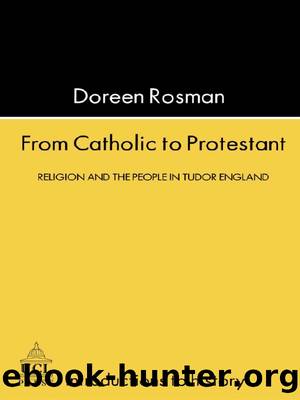From Catholic To Protestant by Doreen Margaret Rosman

Author:Doreen Margaret Rosman [Rosman, Doreen Margaret]
Language: eng
Format: epub
Tags: History, General, Europe, Great Britain, Tudor & Elizabethan Era (1485-1603), Religion, Christian Church, Social Science, Customs & Traditions
ISBN: 9781135365424
Google: PyWPAgAAQBAJ
Publisher: Routledge
Published: 2003-05-20T01:14:54+00:00
The religion of the people
It remains to consider how far these efforts had an effect upon popular belief and practice. To some extent this depended on where people lived. Catholicism persisted in Lancashire long after it had been eroded elsewhere. Protestant clergy worked in parishes and, through lectureships, in market towns. The parish system operated far more effectively in the central and southern lowlands than in the north. Here the spiritual needs of the population had previously been met as much through monasteries and chantry chapels, now defunct, as through the mechanism of vast sprawling parishes. People could more easily gather for âcommon prayerâ in urban areas and compact rural communities than in regions in which a dispersed population lived miles from the nearest church.
As in the past, everyone was required to attend church on Sundays and feast days, but, as in the past, not everyone did. Absence was punishable by a fine of one shilling, levied by churchwardens, who were expected periodically to provide the church authorities with lists of truants. Those cited were liable to be called before church courts, as were the wardens themselves if they were deemed not to be fulfilling their supervisory duties. These arrangements suggest that persistent absentees were more likely to be presented than those who sometimes went to church and sometimes did not. There were clearly far more absentees than those who were reported. Absenteeism may have been particularly marked in the early years of Elizabethâs reign. As the century progressed, greater efforts were made to enforce attendance than had been attempted before the Reformation, with the result that church-going may have increased in the 50 years following 1570. By twentieth-century standards a large proportion of the population attended services, if not every week, at least from time to time. Peter Clark, who stresses the amount of irreligion, has estimated that 20 per cent of the inhabitants of late sixteenth-century Kent were regular absentees, but this implies that four-fifths of Kentish people may have had some sort of contact with the church (Clark 1977:156â7).
In addition to attending services on Sundays and holy days early Elizabethans were expected to receive communion three times a year. This requirement was quietly dropped in 1571, presumably because parishes did not co-operate, and the courts thereafter dealt only with those who missed Easter communion. The practice of communicating at Easter, inherited from the Catholic past, appears to have remained common. After 1559 lay people received both bread and wine rather than just the bread. The prodigious quantities of wine purchased point to large-scale attendance. The churchwardensâ accounts of St Saviourâs, Southwark, record that 67 gallons were bought between 30 March and 5 July 1594 to enable parishioners to attend a communion service in the weeks around Easter. A census authorized by bishops in 1603 indicates that only 1.3 per cent of the eligible population in London failed to receive communion. In Ely, another diocese for which there are clear returns, 2 per cent did not communicate. These
Download
This site does not store any files on its server. We only index and link to content provided by other sites. Please contact the content providers to delete copyright contents if any and email us, we'll remove relevant links or contents immediately.
Room 212 by Kate Stewart(5041)
The Crown by Robert Lacey(4731)
Endurance: Shackleton's Incredible Voyage by Alfred Lansing(4683)
The Iron Duke by The Iron Duke(4293)
The Rape of Nanking by Iris Chang(4139)
Joan of Arc by Mary Gordon(4017)
Killing England by Bill O'Reilly(3953)
Say Nothing by Patrick Radden Keefe(3904)
I'll Give You the Sun by Jandy Nelson(3362)
Shadow of Night by Deborah Harkness(3308)
Hitler's Monsters by Eric Kurlander(3269)
Mary, Queen of Scots, and the Murder of Lord Darnley by Alison Weir(3152)
Blood and Sand by Alex Von Tunzelmann(3140)
Darkest Hour by Anthony McCarten(3072)
Eleanor & Park by Rainbow Rowell(3063)
Margaret Thatcher: The Autobiography by Thatcher Margaret(3029)
Red Famine: Stalin's War on Ukraine by Anne Applebaum(2874)
Book of Life by Deborah Harkness(2869)
The One Memory of Flora Banks by Emily Barr(2803)
